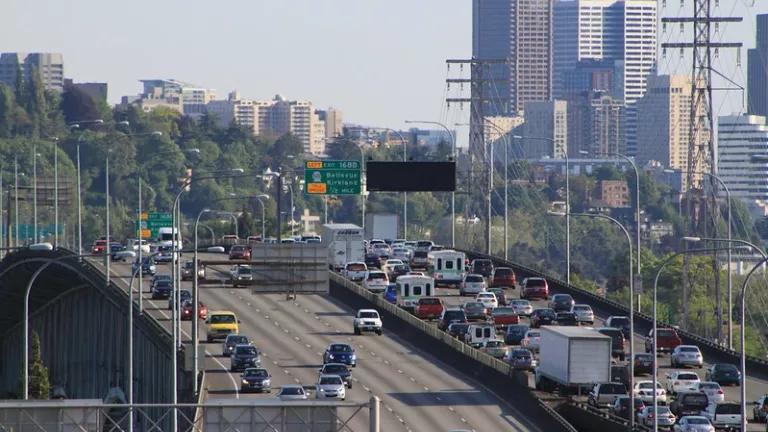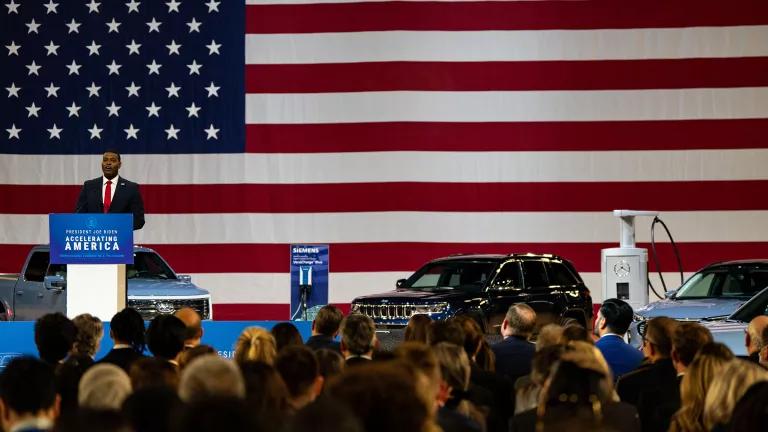States Will Begin Tracking Transportation Emissions
U.S. DOT’s new rule will require states to set declining emissions targets for the transportation sector.

Ship Canal Bridge traffic
SounderBruce via Flickr CC BY-SA 2.0 DEED
On November 22, the U.S. Department of Transportation (USDOT) released its long-awaited Greenhouse Gas Performance Measure rule, which requires states to track and report greenhouse gas (GHG) emissions from their highway systems and to set declining emissions reduction targets. Transportation and climate advocates have been waiting for the release with bated breath, as the rule will make emissions data from the most polluting sector more transparent and accessible. The new rule effectively replicates requirements that were introduced by the Obama administration under authority granted by the transportation infrastructure bills in 2012 and 2015 but were repealed by the Trump administration in 2018 before they could go into effect. The release of this rule is a big win for the USDOT, which has shown a commitment to encouraging states to track the climate impacts of their transportation projects, despite numerous challenges from Republican opponents.
Transportation is responsible for almost a third of GHG emissions nationally, but states and cities are inconsistent in their efforts to track these emissions. According to NRDC’s latest transportation scorecard, just 19 states and the District of Columbia have statewide, near-term transportation sector GHG reduction targets or provide emissions reduction projections for the sector. Additional studies have shown that many cities also do not collect sufficient emissions data to adequately benchmark their progress on climate generally.
What does the rule do and what does this mean for states?
USDOT’s latest rule aims to address the lack of state action on emissions tracking by adding a GHG metric to the existing suite of performance measures in their Transportation Performance Management program. In addition to evaluating elements like safety and reliability, states and metropolitan planning organizations (MPOs) in the 50 states, District of Columbia, and Puerto Rico will now need to track the percentage change in on-road tailpipe emissions from their portions of the National Highway System in relation to a 2022 baseline. In addition, they will need to set two- and four-year declining emissions targets that reflect state conditions and circumstances. There will be no penalties for failing to meet these targets nor are federal decisions dependent on the level or achievement of those targets. States and MPOs will need to report progress every two years.
While these targets may seem like an ambitious undertaking for states, this new rule simply codifies in many ways what states already have the capacity to do. States and MPOs can use data that are collected and displayed publicly by the Federal Highway Administration (FHWA) to create emissions estimates and projections, using guidance provided by the new rule on a standardized approach to calculate these figures. Additionally, the flexibility that is built into the program means that states and MPOs should be able to set targets suited to their particular context. This new measure will not be a big lift for departments of transportation and MPOs.
Why is this rule necessary?
The Bipartisan Infrastructure Law and Inflation Reduction Act (IRA) gave states access to a historic level of funding for transportation infrastructure investments and created several new pots of transportation formula and discretionary funding that prioritize emissions reduction, such as the Climate Reduction Program and the Climate Pollution Reduction Grants. Yet, whether or not states are actually flexing this funding toward projects that do so is unclear. And we have no time to waste. The recently released Fifth National Climate Assessment Report emphasizes that the effects of climate change are getting worse in every region of the United States.
The new GHG performance measure is a necessary policy element that will help kick-start state efforts to invest in transportation projects that actually reduce emissions, allow stakeholders to hold them accountable for climate-related outcomes, and support efforts to ensure that our future transportation systems are cleaner and more sustainable. States, MPOs, and municipalities determine how federal infrastructure dollars are spent on transportation projects and have a wide array of investment options to choose from. Setting targets and tracking emissions give states a baseline to benchmark their progress on climate and will help them direct the flow of dollars toward projects that have proven GHG benefits, including public transit investments, transit-oriented development, and new bicycle and pedestrian infrastructure. These types of investments will be critical to meeting national, state, and local climate goals, as well as creating equitable and accessible transportation systems for all.
In the same vein, this rule will also provide citizens with a layer of transparency that will better help them understand where their federal tax dollars are being spent. At the end of the day, requiring states to track the environmental impacts of their federal transportation dollars is basic good governance.
What comes next?
Now that the rule is in effect, states will need to move quickly to set their targets, which are due to USDOT by February 1, 2024. While the requirements from USDOT go a long way to setting the stage for climate progress, at the end of the day, states and MPOs are responsible for whether or not the rule achieves its intended outcomes. The data needed to set these targets already exist, and as several states already have targets in place, the February deadline is achievable.
More important, support and quick action by states will be needed to push back against continued opposition to the rule. Congressional opponents are likely to attempt rolling back the GHG performance measure requirements while also continuing to call into question USDOT’s authority over these requirements. However, this rule is a no-brainer—it’s a much-needed addition to USDOT’s performance measure program that will enable state transportation policy and investment decision makers to create the clean and equitable transportation systems we need in the future.



